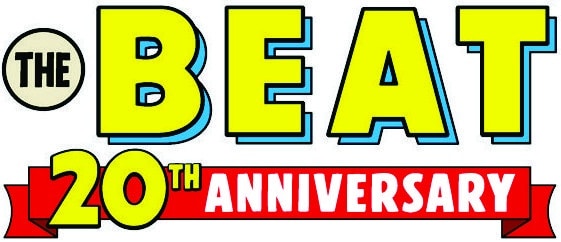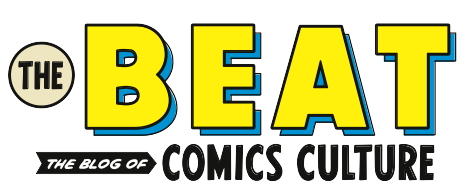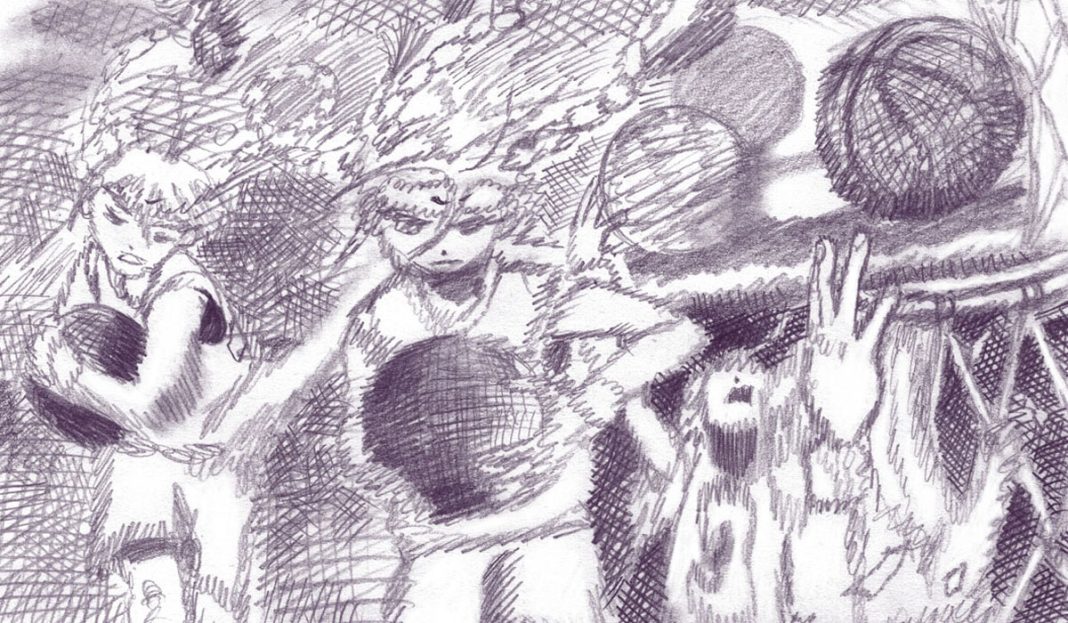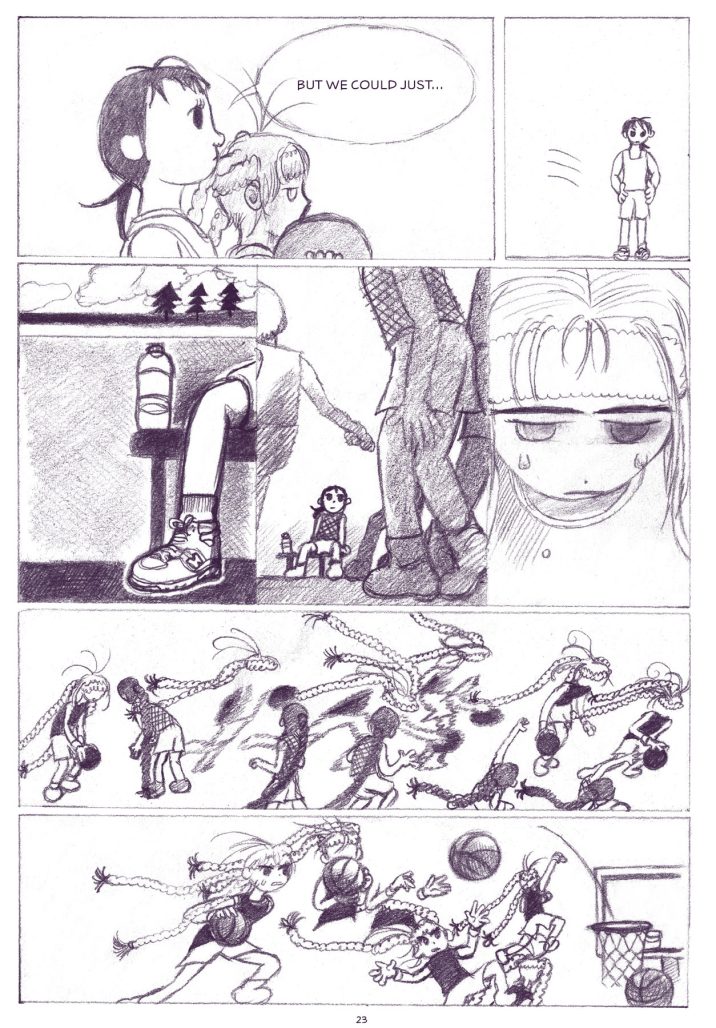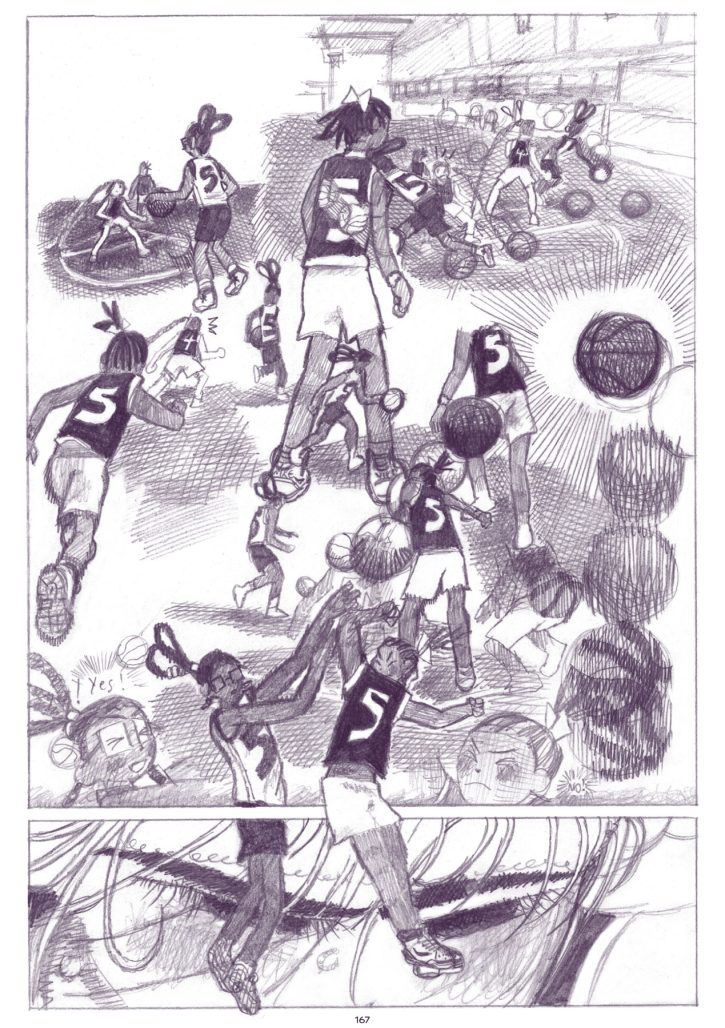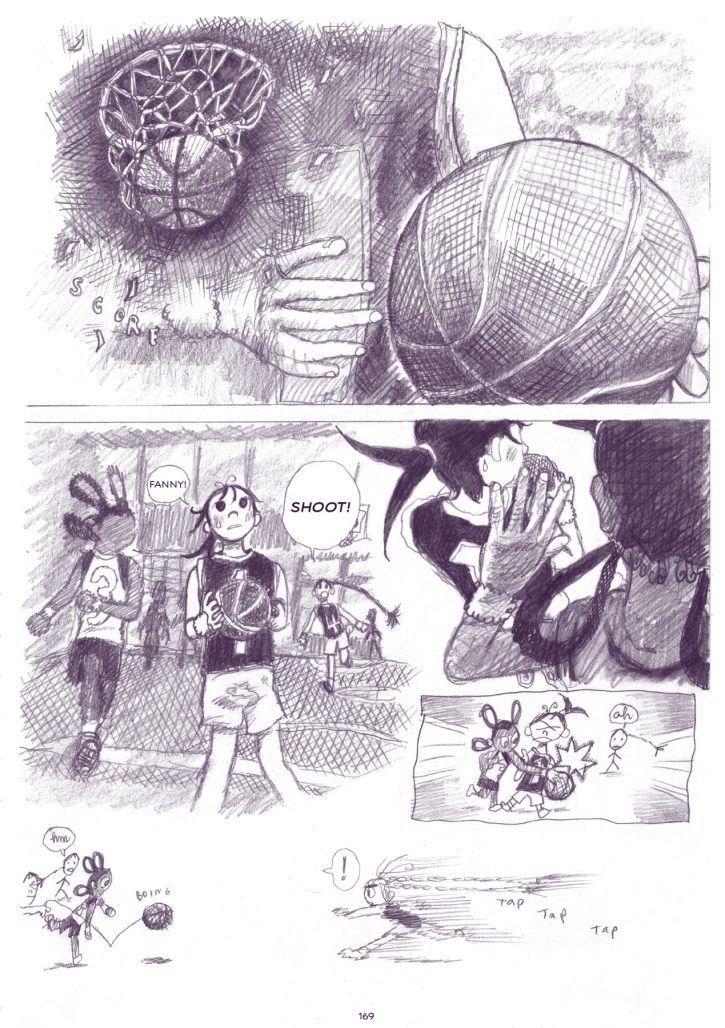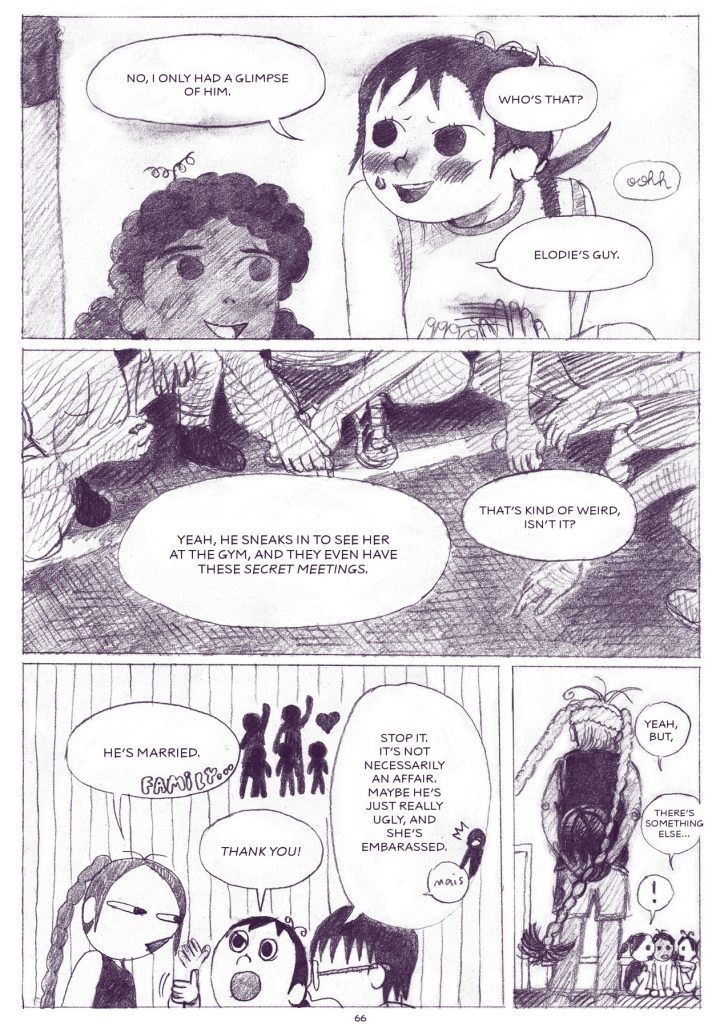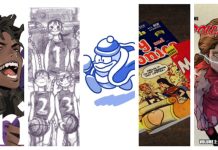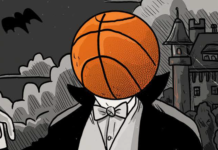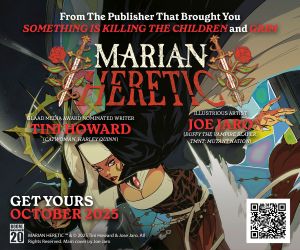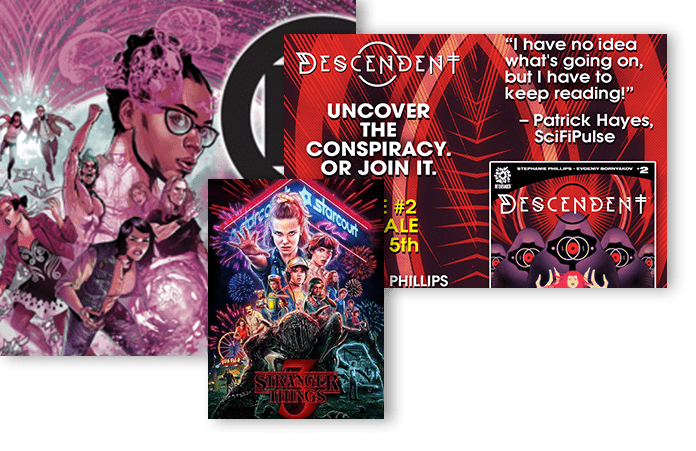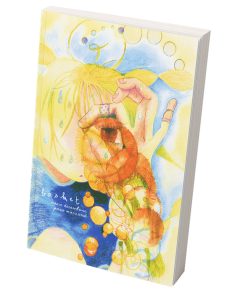
Writer: Paco Moccand
Illustrator: Marie Derambure
Letterer: Steph Bulante
Editors: Sara Hagstrom and Steph Bulante
Publisher: Lucky Pocket Press / $25
Spring 2025
Basket is exactly what you want. The team, scrappy. Chances of winning the big game, slim. Girls, crushing it. There are dueling mysteries driving the first half, who is the coach meeting outside of practice, and what exactly is up with Ines? The management intrigue and dark horse star player collide, and the second half of Paco Moccand’s story plays like a classic of the genre. Training, teamwork, game day, and what comes after. Will Ines and Fanny’s friendship save the team, or sink it? Yet the presentation isn’t what you’d expect. The clean lines of the basketball court are marked up, hatched over, worked and sketched and textured in the doodlepad pencil Marie Derambure employs for the whole of the book.
Gorgeous. All pencils, no inks, tons of texture, printed in “deep plum.” Lucky Pocket Press is one of those publishers who think about the color the book is going to be in, the texture of the pages it’s printed on, the book being in the reader’s hands. Bespoke, and heavily worked, but the opposite of fine and ornate. Sketchy, which is great for action. Basket is very sensual in its appeal, the details of the defensive players blurred out so that the reader experiences the speed at which the girl with pill on fire is flying past them to the hoop.
Derambure’s is a wild style that will switch from panel to panel but also within panels. Like Neighborhood Story by Ai Yazawa as much as a great action ball comic like Sam Bosma’s Fantasy Sports. Unbound by any rules- save the mood the cartoonist was going for in the moment- and yet totally cohesive visually. Detailed to stick-figure, it is all recognizably Basket.
Kind of a straightforward plot, though. A solid story, the front half a mystery, the back half its impact on the Big Game at the end of the season. Sure there are unpredictable turnarounds, but it also makes it clear where it’s headed, and takes you there. Moccand’s story has a sophisticated restraint to it, however. Basket will give you the swish moment and the real sweat getting there, different players training on the same time with conflicting ambitions, practice, endurance, luck. But Moccand leaves out the fabricated moment where victory makes all the girls realize how much they’ve achieved and grown and other cliches a sports story that follows the same game plan tends to drive towards.
The approach speaks in the language of neorealismo. Looks and feels like unadorned slice-of-life. The time spent between games training, on the asphalt court, Ines and Fanny talk about life as they practice their fadeaway, and we get a story told through the girls instead of about them. This unorthodox indie approach is compounded by the heavy sensual focus of the visual storytelling. A very comics-specific thing Basket does is constantly integrating montage into narrative sequences. You see and feel the tiny aspects of the moment that each character is in through cutaway panels, insert shots without narrative explanation but full of emotional resonance, all while the plot is unfolding, sometimes over top of it. A dreamy, surreal thing; it all fits together seamlessly to pull the reader inside, to put their sneakers on the floorboards with Ines.
Derambure’s bending the rules with characters crossing the gutters is 25% dynamic illustration/design choices 75% making a play on the court larger than life, emotionally busting out of reality. For something scribbled everywhere, there’s compelling (often comedic) uses of negative space. Basket is full of multiple exposure moments where widescreen panels become murals, the sequence of rushes and fake-outs that get a player up to the rim are all shown in the same uninterrupted space, forming a De Luca dance line across the page. Showing as telling comics, giving the reader the experience of playing instead of following the announcer’s narration. That’s what we’re here for with comics, right? To see it and be it. Basket obliges.
You could say Basket is manga-informed. Part of a difficult to pin down generational shift away from the spinner rack being the genesis of what comics are like. But stylistically, and to some degree structurally, Basket is dissimilar from manga outside of like Glacier Bay. Actually visually it reminds me of Last Chance to Find Duke, a comic from Peow2 (studio based out of Sweden/New Jersey) by Shang Zhang (a Chinese guy living in France). Comics of a nation on no map. Basket is blurbed as “shojo Slam Dunk;” shojo’s a type of magazine that’s typical contents have become synonymous with an editorial category, one that Basket has writing and art ties to. But. Unless it comes from the shojo magazines of Japan, it’s sparkling girls’ stories.
The things going on beneath the narrative are a bit more josei than shojo; the girls mostly keep their reasons to themselves, but the savvy reader can pick up the social subtext influencing their choices, mining a deeper character experience reflective of the real world. Ines is short, the kind of short that in most cases keeps one from playing pro. Not going to let that stop her from giving her all. Is the game worth playing if you don’t win? The euphoria while playing makes all the practice worth it- and win or lose, after four quarters the game ends. You can lose and still have a good game.
Well, maybe you can. Not an option for Ines. Philosophically it’s admirable to take an L with grace. But that fails to recognize the limited opportunities for girls like her. The odds are stacked against Ines because of her gender, her economic background, her height, her uncompromising attitude- hurdles her career can’t ignore. Judging what she does to get ahead is up to you, she’s not going to make excuses. She’s here to play.
And like I said, this book isn’t about that. It’s about the local club, too small for an air conditioned auditorium, playing one last game against the powerhouse regional favorites. The social subtext is just that. Or maybe it’s about both, all of the pieces and more. Moccand’s story is steady in its progression and Derambure’s story is constant in its experimentation, and they’re the same story. An experience of many genres, many styles, a swirling of seeing and feeling and being.
Comics outpace the language used to describe them. Manga’s influence on contemporary comics (as an aesthetic and storytelling influence) is detached from the aspects of manga’s cultural origin that inform its aesthetic and storytelling choices, capturing the energy of the medium but lacking the nuance of roots. A gap the creators of Basket fill with themselves. Metamodernism is the combination of classic modernist work, earnest attempts to convey a traditional story, with postmodernist approaches embracing revision, told in a dreamy artistic style and from a narrative perspective that tradition could never have dreamed of. Basket is a step past metamodern, changes are made to the form, but not in conversation with the medium, modernism, what has come before- instead speaking to the autonomous outside interests of the creator.
That said, its conversation with the medium is definitely the kind that should be heard, quietly moving the artform significantly forward, if you can find it. Dermabure and Moccand have given the reader a gift, the absolutely unmatched thrill of discovering the rad and the new, a chance to see in something you love something you haven’t seen before. A rare thing, Basket. Unconcerned with all this, fervent and lawless, it tells an obvious fiction truthfully and dreamfully surreal. She shoots, she scores.
Basket is available from Lucky Pocket Press or wherever finer comics, manga, or books are sold.
